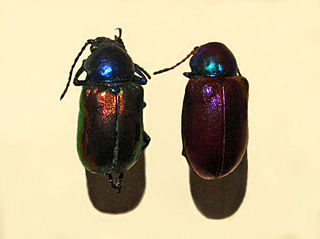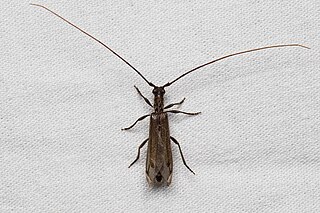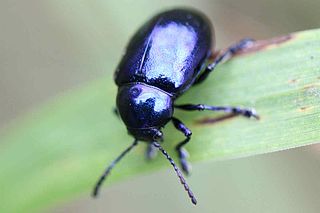
Chrysochares asiaticus is a species of beetles belonging to the leaf beetle family, subfamily Eumolpinae.

Bromius obscurus, the western grape rootworm, is a species of beetle in the leaf beetle family. It is the only member of the genus Bromius. The distribution of the species is holarctic; it can be found in North America, wide parts of Europe, and Asia. The species is a known pest of grape vines in Europe and western North America.

Colasposoma viridicoeruleum is a species of beetle belonging to the family Chrysomelidae, described by Victor Motschulsky in 1860. It is known as a pest of sweet potatoes. The species was formerly known as Colasposoma auripenne until 2003, when C. auripenne was determined to be a synonym of C. viridicoeruleum. It is sometimes considered a southern subspecies of Colasposoma dauricum, using the name Colasposoma dauricum auripenne.

Styloxus fulleri is a species of beetle in the family Cerambycidae. It was described by George Henry Horn in 1880.
Chloropterus mateui is a species of leaf beetle found in Algeria. It was first described as a species of Atomyria in 1969 by Brian J. Selman, based on a series of specimens collected from the western Sahara. One of these specimens was collected from the desert shrub Tamarix. In 2020, A.G. Moseyko transferred the species to the genus Chloropterus.
Acronymolpus is a genus of leaf beetles in the subfamily Eumolpinae. It is endemic to New Caledonia. There are two species placed in the genus, both of which are sexually dimorphic; the females are large and reddish, and the males are small and black. A member of the tribe Eumolpini, Acronymolpus is distinguished from other members of the tribe in New Caledonia by its enlarged metacoxae, which occupy most of the first abdominal ventrite and nearly reach its posterior margin.

Typophorini is a tribe of leaf beetles in the subfamily Eumolpinae. The tribe contains approximately 100 genera, which are found worldwide. Members of the tribe are mainly characterized by notches on the tibiae of the middle and hind legs, which are sometimes referred to as antenna cleaners. They also generally have a subglabrous body, as well as bifid pretarsal claws.

Rhyparida is a genus of leaf beetles in the subfamily Eumolpinae. It is distributed in the Australasian and Indomalayan realms, though some species are also known from the African islands of Madagascar and Seychelles.
Phytorellus is a genus of leaf beetles in the subfamily Eumolpinae, known from the Philippines.
Tricliona is a genus of leaf beetles in the subfamily Eumolpinae. It contains at least 35 species, and is distributed from India and Southern China to the Philippines and New Guinea.
Eka nigra is a species of leaf beetle endemic to Silhouette Island in the Seychelles, in the low country near the coast, and the only member of the genus Eka. The species was first described by the Indian entomologist Samarendra Maulik, from a specimen collected by the Percy Sladen Trust Expedition to the Indian Ocean in 1908. The generic name comes from the Sanskrit word एक (éka), meaning "single", "alone". The genus is related to Trichochrysea.
Aphilenia is a genus of leaf beetles in the subfamily Eumolpinae. It is distributed in Central and East Asia as well as southern Russia. Members of the genus are adapted to dry climates, and feed on bushes of the genus Calligonum. In 2012, the genus was moved from the tribe Bromiini to the tribe Nodinini.
Cleoporus is a genus of leaf beetles in the subfamily Eumolpinae. It is known from Asia.
Atomyria is a genus of leaf beetles in the subfamily Eumolpinae. It is distributed in Central Asia and Iran. In 2012, the genus was moved from the tribe Bromiini to the tribe Nodinini. In 2020, the genus was revised by A. G. Moseyko, who described a new species and transferred two species to Chloropterus, leaving only two valid species remaining within Atomyria.

Chrysochus asclepiadeus is a member of the leaf beetle subfamily Eumolpinae. It is considered the type species of the genus Chrysochus, though it has sometimes been placed within the genus Eumolpus. It is the only species of Chrysochus distributed in the western Palaearctic. It is mainly found in Europe, though it is also known from Kazakhstan and Turkey in Asia.

Arsoa is a genus of leaf beetles in the subfamily Eumolpinae. It was first established by the French entomologist Léon Fairmaire in 1901, for two species described from Androy Plateau, in southern Madagascar. Adult males in the genus have very long forelegs.
Phytorus is a genus of leaf beetles in the subfamily Eumolpinae. It is distributed in Southeast Asia.

Bromiini is a tribe of leaf beetles in the subfamily Eumolpinae. The tribe contains approximately 120 genera, which are found worldwide. They are generally thought to be an artificial group, often with a subcylindrical prothorax without lateral ridges and covered with setae or scales.
Lepina is a genus of leaf beetles in the subfamily Eumolpinae. It is widely distributed in Southeast Asia. It is very close to the genus Apolepis.
Sceloenopla octopunctata, is a species of leaf beetle found in India and Sri Lanka.







